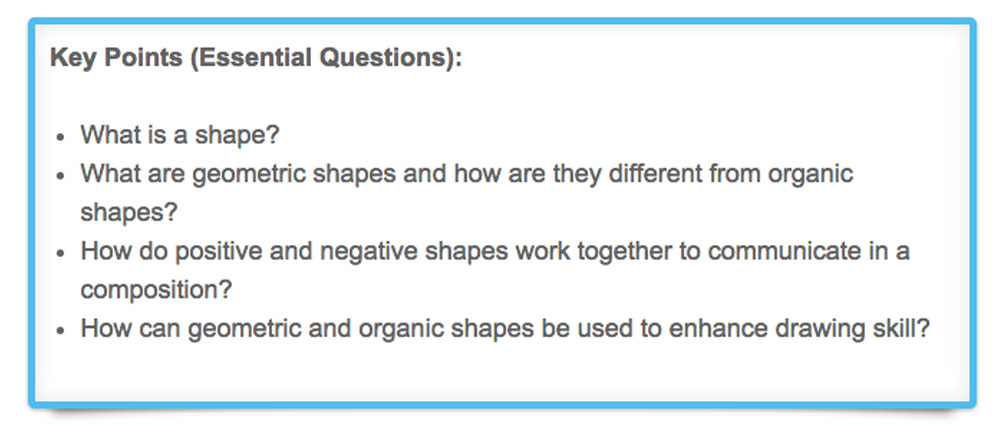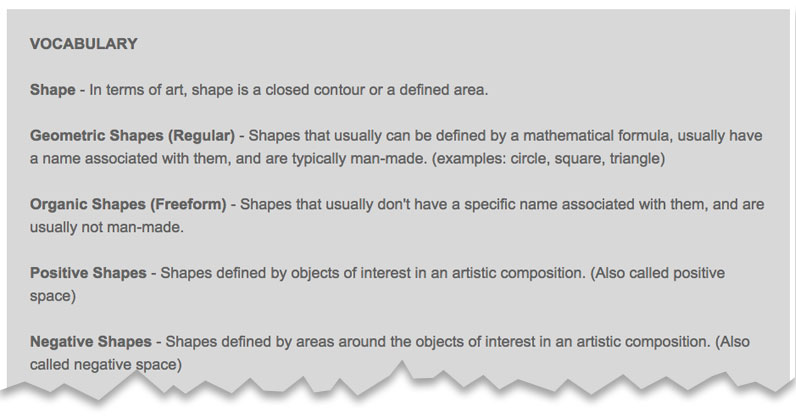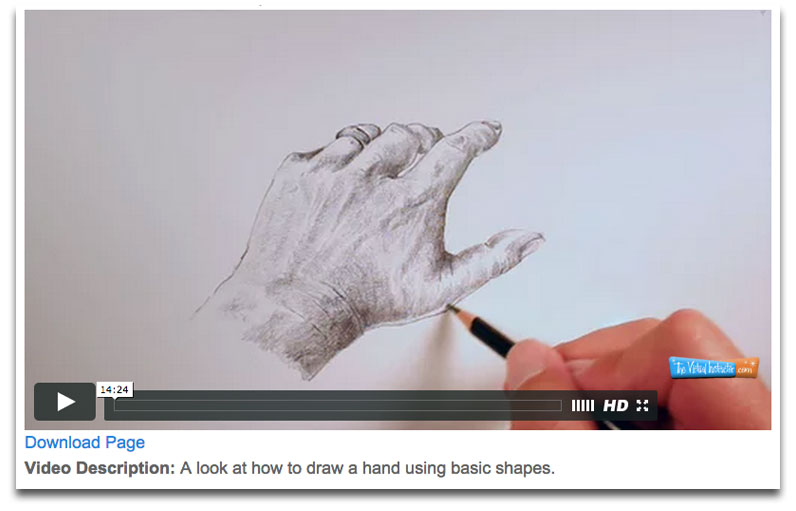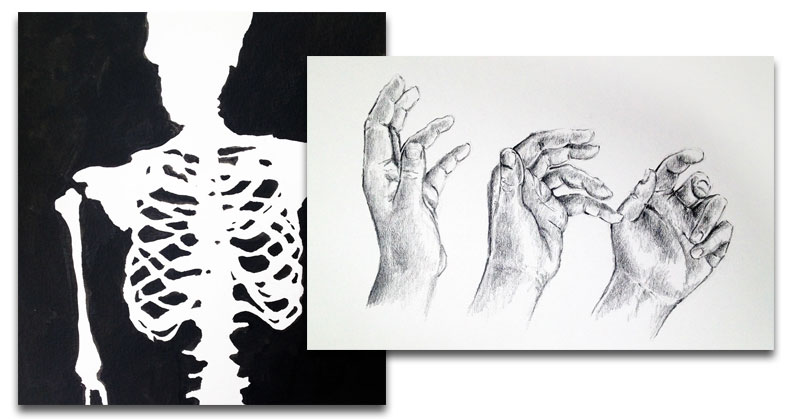Lesson 1 - Line
Description: Students will use their knowledge of line, line quality, and cross contour lines to create a finished line drawing using graphite and pen and ink. The finished image should communicate the illusion of form through the use of line quality and cross contour lines.
Objective(s): The student will learn the concept of line, contour lines, and cross contour lines. The student will learn line quality and it’s effects on form and light. The student will learn how to use cross contour lines to create the illusion of form and light.
Time Frame: 2 weeks
Presentation Slides: 8
Supplementary Videos: 7
Handouts: 5 (including ebooks)
Lesson 2 - Shape
Description: Part One: Students will use their knowledge of positive and negative shapes to create an ink drawing that focuses only on positive and negative shapes of a still life.
Part Two: Students will draw 5 hands from direct observation using simple shapes on white drawing paper with soft graphite pencils.
Objective(s): The student will learn various aspects regarding the element of art, shape including the definition of shape, geometric and organic shapes, positive and negative shapes, and how shape can be used to draw representationally.
Time Frame: 2 weeks (Part 1 – 1 week, Part 2 – 1 week)
Presentation Slides: 14
Supplementary Videos: 6
Handouts: 4 (including ebooks)
Lesson 3 - Form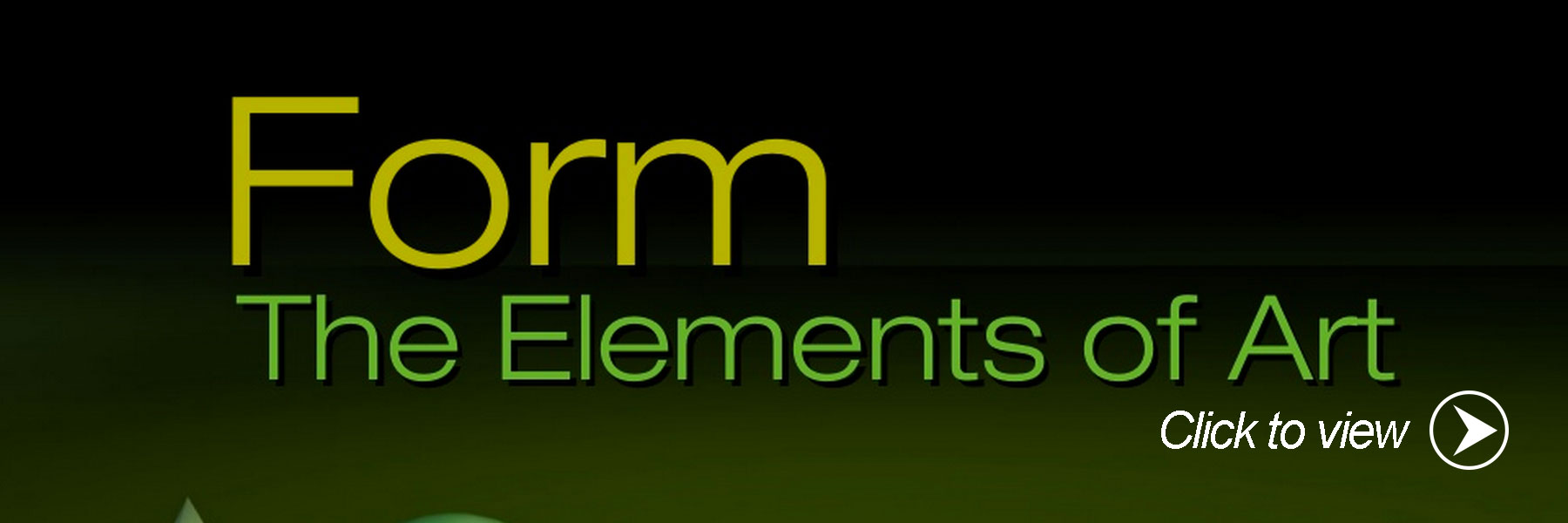
Description: Students will use their knowledge of shadow structure on objects to draw various forms and label shadow structure on them.
Objective(s): The student will learn the differences between shape and form. The student will learn the basic shadow structure on an object and will learn how to apply this structure to objects in a drawing.
Time Frame: .5 weeks
Presentation Slides: 13
Supplementary Videos: 6
Handouts: 3 (including ebooks)
Lesson 4 - Value
Description: Part One Students will use their knowledge of value to draw an egg from observation on white drawing paper using soft graphite. The focus should be to create an accurate rendering of the egg using smooth gradations of value in order to create the illusion of form and light source.
Part Two Students will create a “highlight rendering” of a spotlit still life using vine charcoal, compressed black charcoal, and a kneaded eraser. Students should demonstrate an understanding of the full use of value in a drawing in order to create the illusion of form and light source.
Objective(s): The student will learn the concept of value in terms of art. The student will learn the importance of value in the development of drawings and paintings.
Time Frame: 3 weeks
Presentation Slides: 13
Supplementary Videos: 5
Handouts: 4 (including ebooks)
Lesson 5 - Space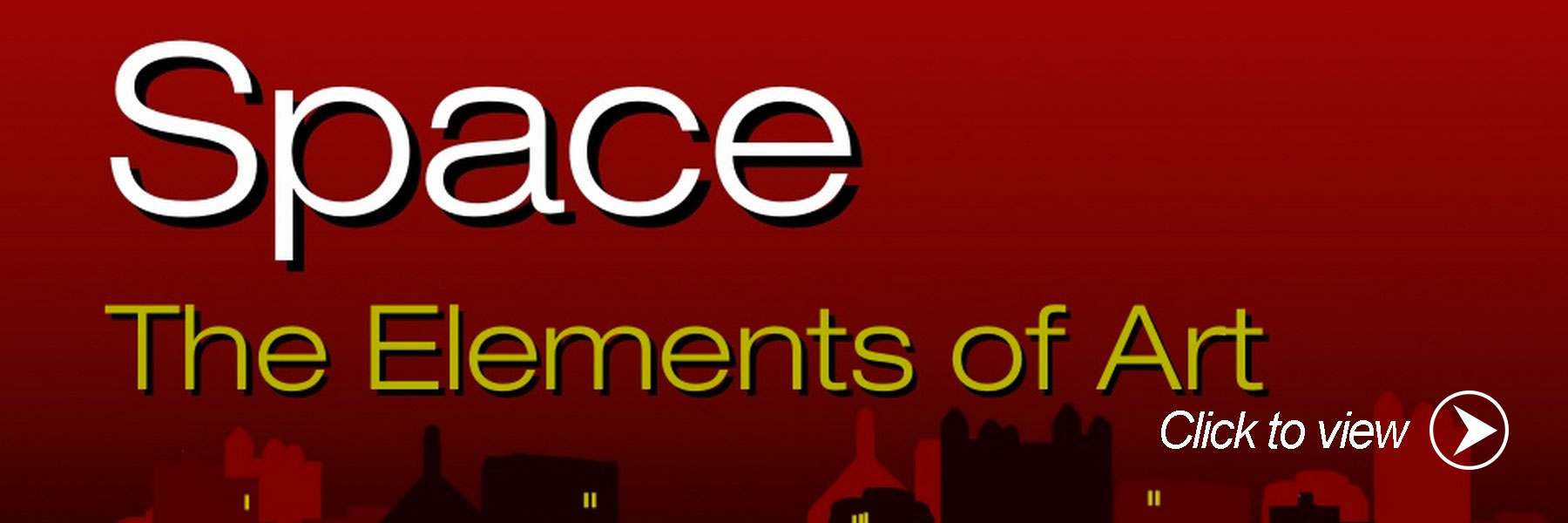
Description: Students will use their knowledge of linear perspective to create a 3-D maze using graphite and white drawing paper.
Objective(s): The student will learn six ways to create the illusion of space on a flat surface. The student will learn how to create the illusion of space using one point linear perspective and two point linear perspective.
Time Frame: 3 weeks
Presentation Slides: 29
Supplementary Videos: 7
Handouts: 5 (including ebooks)
Lesson 6 - Texture
Description: Students will arrange 3 – 5 paper bags in order to draw them from observation. (Students may photograph the arrangement to help remember the arrangement.) Students will draw the bags from observation concentrating on creating the illusion of accurate texture through the use of value.
Objective(s): The student will learn the concepts of creating the illusion of texture in a drawing or painting. The student will apply concepts learned to create a drawing of paper bags from observation using graphite. The student will accurately depict simulated texture through value.
Time Frame: 2 weeks
Presentation Slides: 10
Supplementary Videos: 5
Handouts: 4 (including ebooks)
Lesson 7 - Colored Pencils
Description: Students will use proper colored pencil techniques to draw a collection of transparent marbles from observation.
Objective(s): The student will learn techniques for using colored pencils. The student will will use learned techniques to create a representational drawing of transparent marbles from observation.
Time Frame: 2 weeks
Presentation Slides: 23
Supplementary Videos: 5
Handouts: 3 (including ebooks)
Lesson 8 - Color
Description: Students will practice mixing colors and handling tempera paint by painting the “Activity Worksheets”. Students will use their knowledge of color theory to paint an object from multiple angles using 3 different color schemes.
Objective(s): The student will learn the basics of color theory including specific names and types of colors (Primary, Secondary, Tertiary, Neutral). The student will learn how to mix specific colors on the color wheel using tempera paint.
Time Frame: 2 weeks
Presentation Slides: 29
Supplementary Videos: 6
Handouts: 5 (including ebooks)
Lesson 9 - The Grid Technique
Description: Students will use graphite and tempera paint to create an accurate self portrait.
Objective(s): The student will learn how to use the grid technique to transfer information from a smaller photo to a larger drawing surface. The student will learn the proportions of the face and how to draw individual facial features. The student will finish the portrait using tempera paint and use an optional color scheme.
Time Frame: 4 weeks
Presentation Slides: 10
Supplementary Videos: 4
Handouts: 4 (including ebooks)
Lesson 10 - Soft Pastels
Description: Students will use soft and/or hard pastels to create a pastel landscape drawing of place with some personal significance to themselves.
Objective(s): The student will learn techniques for creating the illusion of space in a pastel landscape utilizing atmospheric perspective. Harmony and unity can be addressed in this lesson as well in respect to applying harmonious colors and values through the picture plane.
Time Frame: 2 weeks
Presentation Slides: 18
Supplementary Videos: 7
Handouts: 2 (including ebooks)
Lesson 11 - Figure Drawing
Description: Students will create a series of gesture drawings from observation using soft graphite pencils on newsprint paper. Students will use the knowledge gained from warm up activities to create a completed figure drawing with oil pastels.
Objective(s): The student will learn the basics of figure drawing including gesture drawing. The student will learn a four step process of observation that can aid in drawing the human figure.
Time Frame: 2 weeks
Presentation Slides: 23
Supplementary Videos: 4
Handouts: 2 (including ebooks)
Lesson 12 - Clay Figures
Description: Students will create small clay figures out of white or red earthenware. (If a kiln is not available, Air Dry Clay can be substituted) Students will work the clay in both the “wet” and “leather-hard” stages to create sculptures that support themselves.
Objective(s): The student will learn the basics of sculpting with clay by constructing a clay figure. The student will be exposed to clay terminology.
Time Frame: 3 weeks
Presentation Slides: 9
Supplementary Videos: 3
Handouts: 1
Lesson 13 - Giant Junk Food
Description: Students will work in groups or independently to create giant papier-mâché sculptures of junk food. Students will create over-sized sculptures that are a reflection of one form of popular culture - junk food.
Objective(s): Students will be required to work together to engineer an armature before applying glued strips of newspaper to the structure and finishing with a primer base and tempera or acrylic applications.
Time Frame: 4 weeks
Presentation Slides: 9
Supplementary Videos: 2
Handouts: 1
Lesson 14 - Crayon Etching
Description: The student will learn the process of crayon etching while gaining an understanding of a "resist". The student will learn how to incorporate pattern into art works. The student will learn the similarities and differences of regular patterns and irregular patterns.
Objective(s): Students will create a large, brightly colored crayon etching, applying various patterns by scratching out (etching) areas of ink or tempera paint to reveal the crayon applications underneath.
Time Frame: 4 weeks
Presentation Slides: 14
Supplementary Videos: 2
Handouts: 1
Lesson 15 - Relief Printmaking
Description: The student will learn the process of relief printmaking by creating a series of hand-pulled prints carved from linoleum blocks. The student will learn to create balance between dark and light areas by creating a variety of lines and shapes in their prints.
Objective(s): Students will create a series of hand-pulled relief prints, carved from linoleum, and printed on slightly larger paper.
Time Frame: 2 weeks
Presentation Slides: 16
Supplementary Videos: 2
Handouts: 1
Lesson 16 - Assemblage Sculpture
Description: The student will be exposed to the art-making technique of "assemblage" by collecting and assembling found objects to create a figurative sculpture. The student may find objects that are related in some manner and should be challenged to create a sculpture that supports itself.
Objective(s): Students will create self-supporting figurative assemblage sculptures made of related found objects.
Time Frame: 1 week
Presentation Slides: 7
Supplementary Videos: 2
Handouts: 1



